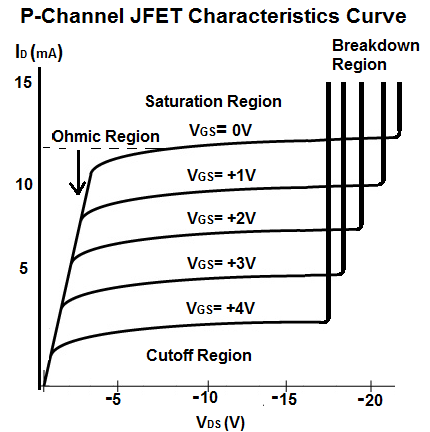P-channel JFET Basics

A P-Channel JFET is a JFET whose channel is composed primarily of holes as the charge carrier. This means that when the transistor is turned on, it is primarily the movement of holes which constitutes the current flow.
This is in contrast to N-Channel JFETs, whose channel is composed primarily of electrons, which constitute the current flow.
A P-Channel JFET is composed of a gate, a source and a drain terminal.


It is made with an p-type silicon channel that contains 2 n-type silicon "bumps" placed on either side. The gate lead is connected to the n-type bumps, while the drain and source leads are connected to either ends of the p-type channel.
When no voltage is applied to the gate of a P-Channel JFET, current (holes) flows freely through the central P-channel. This is why JFETs are referred to as "normally on" devices. Even without any voltage, they conduct current across from source to drain.
How a P-Channel JFET Works
This is a typical diagram you would see of voltage biasing of a P-channel JFET. This diagram also serves to show you all the parts of a P-channel JFET.

How to Turn on a P-Channel JFET
To turn on a P-channel JFET, apply a negative voltage VDD to the drain of the transistor with respect to the source (the source must be sufficiently more negative than the drain (Vs>VD). This will allow a current to flow through the drain-source channel. If the gate voltage, VGG, is 0V, the drain current is at its largest value for safe operation, and the JFET is in the On condition.
So with a sufficient negative voltage, VDD, and no voltage (0V) applied to the base, the P-channel JFET is in maximum operation and has the largest current.
How to Turn Off a P-Channel JFET
To turn off a P-channel JFET, there are 2 steps you can take. You can either cut off the bias negative voltage, VDD, that powers the drain. Or you can apply a positive voltage to the gate (relative to the source (S)). When a positive voltage is applied to the gate, the drain current is reduced. As the gate voltage, VGG, becomes more positive, the current lessens until cutoff, which is when then JFET is in the Off condition. This stops a large drain-source current.
Characteristics Curve of a P-Channel JFET
The characteristics (also called transconductance) curve of a JFET transistor is the the graph of the drain current, ID verses the gate-source voltage, VGS.
The transconductance curve, as for all semiconductor devices, is nonlinear, for most of the curve, meaning changes to VGS do not directly increase or decrease drain current, ID.
Below is the characteristics curves of P-Channel JFET transistor:


An P-Channel JFET turns on by taking a negative voltage to the drain-source terminal of the transistor and a gate-source voltage, VGS, between 0V and +4V. It shuts off by taking in a positive gate-source voltage, VGS, above +4V.
Regions of the Characteristics Curve
The Regions that make this characteristic curve are the following:
Cutoff Region- This is the region where the JFET transistor is off, meaning no drain current, I D flows from drain to source.
Ohmic Region- This is the region where the JFET transistor begins to show some resistance to the drain current, Id that is beginning to flow from drain to source. This is the only region in the curve where the response is linear.
Saturation Region- This is the region where the JFET transistor is fully operation and maximum current, for the voltage, VGS, that is supplied is flowing. During this region, the JFET is On and active.
Breakdown Region- This is the region where the voltage, VDD that is supplied to the drain of the transistor exceeds the necessary maximum. At this point, the JFET loses its ability to resist current because too much voltage is applied across its drain-source terminals. The transistor breaks down and current flows from drain to source.
No comments:
Post a Comment